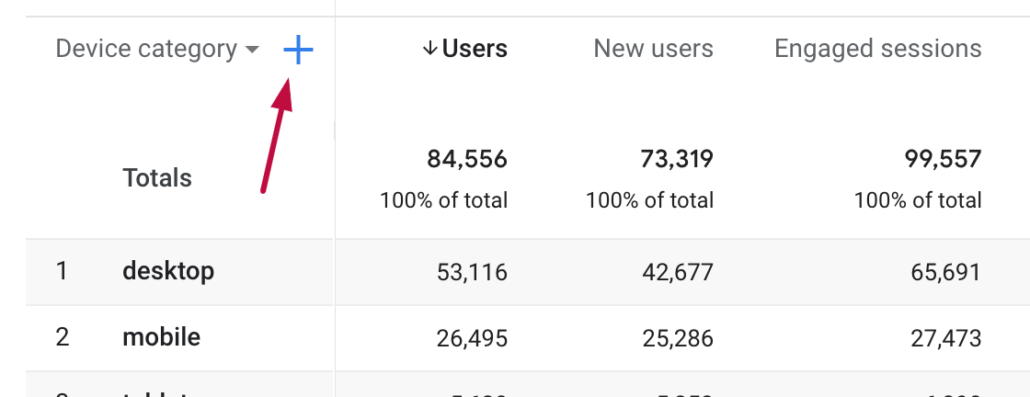Understanding Secondary Dimension in Google Analytics: A Total Overview
Understanding Secondary Dimension in Google Analytics: A Total Overview
Blog Article
Enhance Your Data Analysis Utilizing Additional Dimension in Google Analytics
Discovering the capacities of secondary dimensions in Google Analytics opens a realm of possibilities for refining data analysis. By layering added dimensions onto key data sets, an even more complex story arises, dropping light on user interactions and efficiency indicators.
Recognizing Additional Dimensions
Secondary dimensions in Google Analytics refer to added parameters that can be added to the main measurement, enabling for a more in-depth analysis of data (Secondary Dimension in Google Analytics). By integrating additional measurements, analysts can section and filter data to discover patterns, trends, and correlations that may not be noticeable when looking at the information as a whole.

Advantages of Using Secondary Dimensions
When evaluating information in Google Analytics, the application of secondary measurements supplies very useful understandings right into user habits and performance metrics. By adding an additional dimension to your main information, you can dig much deeper into the characteristics of your internet site visitors and their interactions.
In addition, additional measurements aid in identifying patterns and relationships that might not be instantly obvious when considering the information alone. This deeper degree of analysis can discover beneficial info that can lead marketing strategies, website optimization, and overall company decisions. Furthermore, second dimensions enhance the context of your main information, supplying an extra detailed sight of customer interaction and performance metrics. On the whole, the use of secondary measurements in Google Analytics can substantially improve the deepness and high quality of your information analysis, causing more educated decision-making and enhanced outcomes.
Just How to Include Secondary Dimensions
By incorporating second measurements in Google Analytics, users can gain much deeper insights right into their data analysis procedure, allowing for more extensive examination of customer actions and efficiency metrics. Including secondary measurements is an uncomplicated procedure that can dramatically enhance the depth of evaluation. To add an additional measurement in Google Analytics, beginning by browsing to the report you wish to examine. As soon as in the record, situate the "Secondary dimension" tab above the data table. Click it to disclose a dropdown menu with numerous choices such as Habits, Technology, and Custom Capacities. Select the measurement you wish to include, such as 'Source/Medium' or 'Gadget Group'. This additional measurement will after that be related to your existing data, giving added context and permitting for an extra detailed analysis of customer interactions. By making use of second measurements effectively, customers can discover useful understandings that might have or else been ignored, leading to educated decision-making and improved efficiency techniques.
Studying Data With Additional Dimensions
Utilizing secondary dimensions in data evaluation gives an extra detailed understanding of customer actions and performance metrics. By adding a secondary dimension to your primary information embeded in Google Analytics, you can delve deeper into the qualities of your web site visitors and their interactions. Incorporating the key This Site dimension of 'source/medium' with the additional measurement of 'landing web page' can disclose which specific pages are bring in web traffic from different sources, helping you maximize these web pages for much better interaction.

In significance, evaluating information with second dimensions empowers you to acquire valuable insights right into individual actions, recognize trends, and make notified choices to improve the performance of your digital residential properties.
Best Practices for Second Measurements
In data analysis, integrating additional measurements properly can dramatically boost the deepness of understandings originated from metrics and individual actions patterns. When utilizing additional dimensions in Google Analytics or any type of various other analytical device, it is essential to stick to finest practices to guarantee the precision and relevance of the data evaluation.
One key finest practice is to meticulously pick additional dimensions that complement the primary dimension being assessed. Picking second measurements that provide added context or more division can use a more comprehensive understanding of the information. It is also important to prevent overcomplicating the analysis by consisting of also several secondary measurements, which might bring about confusion or dilution of insights.
Moreover, it is a good idea to explore various combinations of additional and key dimensions to uncover new relationships and patterns. Consistently fine-tuning the selection and examining of secondary dimensions based on the certain objectives of the analysis can bring about more workable insights. By complying with these best techniques, data experts can leverage additional dimensions properly to boost the general information analysis procedure and decision-making abilities.

Final Thought
In conclusion, incorporating additional dimensions in Google Analytics is important for an extensive information analysis technique. By leveraging second measurements together with main ones, analysts and marketing experts can discover valuable understandings and relationships that can inform decision-making and optimize electronic advertising and marketing approaches. Understanding just how to effectively make use of secondary measurements why not check here and adhering to finest methods will enable experts to draw out meaningful information and enhance their total efficiency metrics.
Additional dimensions in Google Analytics refer to additional criteria that can be added to the main measurement, enabling for an extra in-depth evaluation of data. By incorporating secondary dimensions, experts can segment and filter data to reveal patterns, patterns, and correlations that might not be evident when looking at the information as a whole. Integrating the main dimension of 'source/medium' with the secondary measurement of 'touchdown page' can disclose which particular pages her explanation are drawing in website traffic from different resources, assisting you maximize these pages for better engagement.
One trick best technique is to thoroughly pick secondary dimensions that complement the main measurement being analyzed. By following these ideal techniques, information analysts can utilize additional dimensions efficiently to boost the total information analysis process and decision-making capabilities.
Report this page